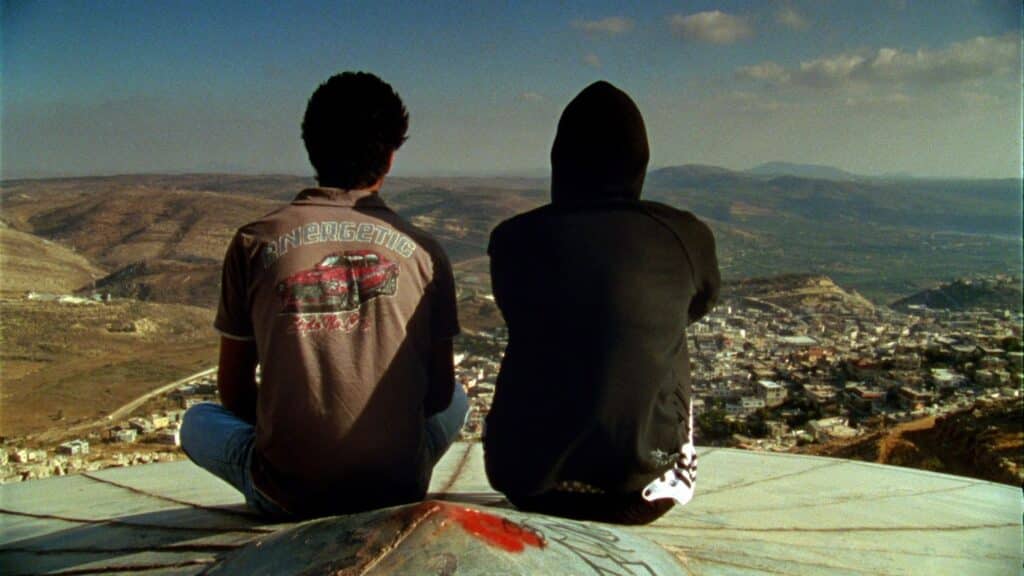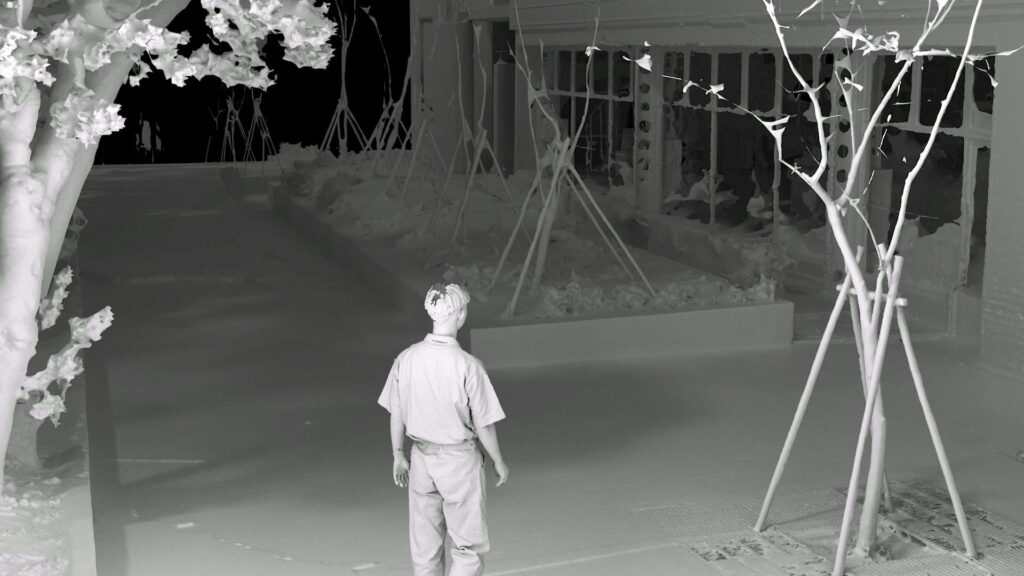Een vleugje nostalgie met nieuw en spannend. Zo voelt het als je de nieuwe trap oploopt van dat prachtige, negentiende-eeuwse gebouw in het Amsterdamse Vondelpark, waar over een paar dagen de flamboyante openingsweek van IDFA’s Documentaire Paviljoen plaatsvindt.
Tot zo’n twaalf jaar geleden was dit de plaats waar het Filmmuseum het publiek verwelkomde. In de tussentijd maakten omroepen, met name AVROTROS, er gebruik van. Nu gaat IDFA er een stevig nieuw stempel op zetten. En gaan de deuren weer open voor publiek, documentaireliefhebbers in de eerste plaats. Het belooft een tamelijk uniek centrum te worden, waar veel meer gebeurt dan alleen filmvertoningen. Een ‘huis voor de documentaire’ is deze nieuwe ontmoetingsplek al genoemd. Vondelparkpaviljoen wordt Documentaire Paviljoen.
Caleidoscopisch programma
Onder de noemer Under Construction geeft IDFA al een paar maanden voorproefjes. Binnenkort, van 16 t/m 23 maart om precies te zijn, is de echte openingsweek met een caleidoscopisch programma. Een programma waarin de grenzen tussen kunst, technologie en realiteit vervagen. Van film tot virtual reality, van klassiek tot experimenteel. Met voorstellingen, inleidingen, ontmoetingen en nagesprekken.
Hoe dit zo kon opbloeien is welbeschouwd een fortuinlijke samenloop van omstandigheden. De gemeente Amsterdam had graag dat deze locatie weer meer open voor publiek zou zijn. Ze bracht het onder de aandacht van onder andere IDFA. Dat was op dat moment juist bezig nieuwe kantoorruimte te zoeken. En er sluimerde daar de gedachte aan een eigen plek voor al die activiteiten die IDFA ook al door het jaar heen naast het festival organiseert. “Want”, zo benadrukt programma manager Wotienke Vermeer met zichtbaar enthousiasme, “IDFA is al lang uitgegroeid tot veel meer dan een festival. Het is een instituut dat mensen en ideeën bij elkaar brengt.”
Under Construction
Zo kon één plus één drie worden. Vorig voorjaar werd begonnen met de verbouwing. Afgelopen zomer vond de verhuizing al plaats. Vanaf oktober is er het proefprogramma Under Construction, met ongeveer wekelijks een publieks- of schoolvoorstelling en ook verhuur. Een voorbeeld van dat laatste zie ik toevallig wanneer ik voor dit artikel even ga kijken. Medewerkers van Wie is de Mol zijn er dan keihard bezig om een van de ruimtes om te toveren tot de studio voor de uitzending van de finale. Zo steunt dat programma ook de documentaire.
Under Construction was onder meer bedoeld om de mogelijkheden van het gebouw een beetje te leren kennen en om partners daarbij te betrekken. De aftrap was op 4 oktober in samenwerking met het Stedelijk Museum. De vertoning van All the Beauty and the Bloodshed van Laura Poitras over kunstenaar en activist Nan Goldin viel samen met Goldins solotentoonstelling in het Stedelijk kreeg. Een ander voorbeeld was The Last Year of Darkness over een van de laatste vrijplaatsen voor jong en onconventioneel in China. Met aansluitend een queer performance, georganiseerd samen met het Darkmatter kunstenaarscollectief. Of, recenter, met UvA-studenten, Silence of Reason, over de gruwelijke ervaringen van vrouwen tijdens de Bosnische oorlog, aan het licht gebracht tijdens het Joegoslaviëtribunaal. Maar ook simpelweg een prachtige reprise van De platte jungle (1978) van een van Nederlands meest vooraanstaande documentairemakers Johan van der Keuken (1938-2001).
Openingsweek: docu in turbulente tijd
Voor de openingsweek vroeg IDFA een aantal filmmakers, kunstenaars, én een groep scholieren om ieder een dag in te vullen. Dat leverde een veelkleurig programma op met films, talks en performances. “Fantaseer met ons mee. Waar zou je enthousiast van worden. Wat kan documentaire betekenen in deze turbulente tijd?” Dat was de uitnodiging.

Ester Gould, bekend van de veelgeprezen series Klassen en Schuldig, trapt op 16 maart af met drie betrekkelijk korte films, waaronder Martin Scorsese’s oerfilm Italianamerican (1974). Met aansluitend de talk Manieren van kijken, waarin Gould een inkijkje geeft in manieren van verhalen vertellen en documentaires maken. “Het gaat voor mij over research. Documentaire-research is een manier van kijken.”
Opkomend regisseur Festus Toll onderzoekt koloniale sporen en nodigt daarvoor jonge kunstenaars uit wiens werk in de verschillende diaspora’s geworteld is. Filmmaker Vincent van Monnikendam toont een aantal persoonlijke favorieten en gaat in een Talk in op zijn kenmerkende, observerende werkwijze. Aliona van der Horst viert in haar programma herinneringen, met name hoe die in relatie staan tot film. Het maatschappelijk betrokken collectief Jong Fruit van zes jongeren presenteert hun blok favoriete korte films. Multimediakunstenaar Ali Eslami stelt een programma van korte films en VR-werken samen over de vele gebieden op aarde die door oorlogen zijn getroffen. Wat weten we daar wel en niet over.

Culturele huiskamer
‘Een nieuwe culturele huiskamer van Amsterdam’, noemt IDFA het paviljoen. De oorspronkelijke renaissance-lijnen en de nieuwe stijl van royaal aangepakte verbouwingen met nieuwe kunstwerken lopen soepel door elkaar.
Wanneer ik over de uitnodigende trap via het bordes naar binnen ga zie ik links de Spiegel. Dat is de vaste bioscoopzaal, opnieuw ingericht met 70 ruime zitplaatsen. Documentaire als spiegel van de tijd, dus.
Rechts is Podium, een flexibele ruimte voor allerlei activiteiten, van exposities tot diners. Daarnaast de kleinere Salon, geschikt voor workshops maar ook voor installaties of als werkruimte voor makers die projecten aan het ontwikkelen zijn. En als je de tegenover de ingang geïnstalleerde bar passeert kom je in de zogenaamde Huiskamer. Daar kan je gewoon kan gaan zitten om als bezoeker alles even te verwerken. Of als filmmaker om met een partner in crime nieuwe plannen te smeden. De trap omlaag leidt als vanouds naar het restaurant Park Zuid, waar je ook je koffie kan bestellen.
Jaar vol ontwikkeling
Na de openingsweek komt het Documentaire Paviljoen in vol bedrijf. Meest zichtbaar voor publiek zijn de voorstellingen op woensdag, vrijdag en zondag. Vermeer legt uit dat het daarbij niet de bedoeling is om een concurrent te worden van vertoningen van nieuw uitgebrachte documentaires in de filmtheaters. Daarvoor is er in Amsterdam al een rijke infrastructuur. Het Documentaire Paviljoen zal geen premièretheater zijn. Wel kunnen er films vertoond worden die geen reguliere distributie hebben gekregen. Of er kan met distributeurs gekeken worden naar een manier om de uitbreng van nieuwe titels te ondersteunen. Zoals bijvoorbeeld eerder werk van een regisseur.
Daarnaast zijn er activiteiten in meer besloten setting, er zijn slots voor persvoorstellingen en de verhuur met partners hoort er ook bij. Het wordt flexibel experimenteren met de mogelijkheden. Onderzoeken wat het betekent om onderdeel uit te maken van het ritme van de stad.
Nieuwe media
En het blijft niet bij film. Het Documentaire Paviljoen is een uitgelezen kans om IDFA’s DocLab, al een prominent onderdeel van het festival, verder uit te bouwen. Denk aan VR, interactieve programma’s en vergelijkbare ervaringen voor nieuw en jong publiek, professionals en studenten. Het hele jaar door nu.
IDFA’s DocLab presenteert werk dat vragen stelt over hoe wij ons verhouden tot nieuwe technologieën, naast werk dat thema’s als klimaatcrisis, inclusie en (on)veiligheid invoelbaar kan maken. Een plek ook die een belangrijke ondersteuning kan zijn voor de tot nu toe lastige distributie en presentatie van nieuwe mediawerken. Om van start te gaan zal er in Podium in april een VR-gallery zijn.
Even belangrijk is ook de ondersteuning van de creatieve krachten in de documentairewereld. Zoals het al langer lopende trainingsprogramma IDFA Project Space, waar beginnende makers zich bij het ontwikkelen van een nieuw project kunnen laten steunen door ervaren collega’s.
Het is een voorbeeld dat onderstreept dat het Documentairepaviljoen ook de plaats wil zijn waar professionals uit de sector, met name producenten, makers en financiers bij elkaar komen. De plek, zoals gezegd, waar mensen en ideeën elkaar ontmoeten.
Educatie
En last but nog least: ook educatie is een belangrijk speerpunt. Het festival kent al jarenlang een groot scholierenprogramma, en er is gewerkt met UvA-studenten die een master Preservation & Presentation of the Moving Image doen. Ook wordt er al jaren samengewerkt met de Kunstschooldagen. Voor al dergelijke activiteiten, die ook buiten het festival plaatsvinden, is er nu een vaste plek gekomen. “Spannend om te zien hoe die tak van IDFA hier nog verder uitgewerkt kan worden”, meent Vermeer. Hoe kan je bijvoorbeeld educatie en nieuwe media nog beter bij elkaar brengen.
Flexibiliteit is bij dit alles belangrijk. Het moet door het jaar heen geen vast ingekaderd programma worden. Vooral de eerste tijd zal het Documentaire Paviljoen een plek worden waar iedereen kan wennen aan de mogelijkheden die deze nieuwe locatie biedt. Een plek om te groeien en dingen uit te vinden. Afgaande op de reacties is het duidelijk dat zowel IDFA-medewerkers als documentairemakers vol vuur zijn.
